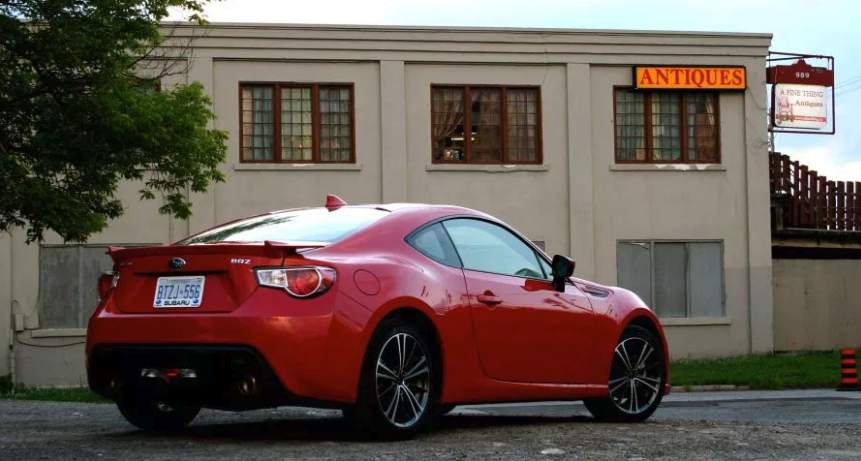Road Test: 2016 Subaru BRZ

Story and photo by John LeBlanc
I’m not a big hugger, but I’d happily wrap my arms around Akio Toyoda – Toyota‘s president and CEO – and give him a squeeze of thanks for the Subaru BRZ.
Wanting to prove to the world his namesake company’s capability of producing more than just appliance-like Corolla and Camry sedans, Toyoda enlisted fellow Japanese automaker Subaru, which Toyota partly owns, to help develop and build a rear-wheel-drive sports car. First seen as the Toyota FT-HS concept at the 2007 Detroit show, the production version hit foreign markets as the Toyota GT86, Subaru BRZ and in North America, the Scion FR-S.
Since then, driving enthusiasts have raved about the BRZ’s back-to-basics driving dynamics, for which Subaru can take most of the credit. The automaker, best known for its all-wheel-drive WRX and STI, handled most of the BRZ/GT86/FR-S development. Subaru supplied the engine, built the chassis and assembles the final the car in Gunma, Japan. Toyota gets credit for the styling and adding its direct-injection hardware to Subaru’s normally aspirated 2.0-litre flat-four engine.
Four model years is a lifetime in today’s automotive industry, though – particularly for a vehicle that’s supposed to tap into the late 20th-century Japanese sports car zeitgeist. So, is a small, rear-wheel-drive sports car like the BRZ still relevant in today’s SUV- and crossover-dominated new car market?
Although there have been rumours of convertible and STI variants, the 2016 BRZ is still only available as it arrived in 2012: a hardtop sports car with one engine and the choice of either a six-speed manual or automatic transmission. The latter tacks $1,200 onto the BRZ’s $27,395 base price.
While the base BRZ already comes well equipped – including Subaru’s all-new Starlink infotainment system, which includes navigation and satellite radio – my tester came as the automotive higher-powers intended, with a manual transmission. For a bare-bones sports car, my tester’s $2,000 Sport Tech package, which adds push-button start, heated seats, a rear spoiler, fog lights and automatic climate control, seems superfluous.
One of the BRZ’s biggest appeals has always been that it isn’t a crossover. As one of the few small, four-cylinder, RWD two-doors available new – including the $36,000 BMW 228i, $31,900 Mazda MX-5 and the nearly identical $27,490 Scion FR-S – the BRZ stands out on any street.
Before I drove it out of my laneway, I got to appreciate the BRZ’s no-nonsense and intimate cabin. Rather than being a taller-riding Volkswagen GTI, the BRZ’s ground-hugging driving position coincides with the Subaru sports car’s low centre of gravity; at just over 46 centimetres, it’s lower than a Porsche Cayman.
The interior bits you engage with most – seats, steering wheel and shifter – are all driver-oriented kits in the BRZ. Its tightly spaced pedals offer easy heel-and-toe motions, while the short-throw gear shifter is close by the steering wheel. Plus, with driver instrumentation clear and easy to read, the dash is very minimal.
As much as front occupants will enjoy spending time in the BRZ, I wouldn’t put anyone on my Christmas card list in the small back seats. I suspect the BRZ’s “+2” rear squabs will rarely be used for human occupation. And, with only 196 litres of space, the Subaru’s small rear trunk is no match for the relatively cavernous confines of a hatchback; it will fit a Speedo swimsuit and not much else.
The sum of the Subaru sports car’s tidy dimensions is feather-like 1,254-kilogram curb weight. That’s good news for power-to-weight fetishists because the BRZ’s four-cylinder only puts out 200 horsepower and 151 lb.-ft. of torque. As tested by Subaru, the result is a zero-to-100-km/h time of 7.7 seconds – one of Toyota’s boring sedans could beat that.
Of course, dropping in the Subaru WRX‘s 2.0-litre turbo-four, with 268 horsepower and 258 lb.-ft. of torque, would definitely make the BRZ faster in a straight line. But, the extra weight might screw up this sports car’s incredibly tactile driving dynamics. Commuters, please note: driving the BRZ is an act of full commitment.
Every aspect of the road you’re driving is transmitted back into the driver’s cerebral cortex. It starts with a quick steering setup that adds weight the more you turn the tiller. Drivers used to front-wheel drive may find the Subaru’s rear-drive chassis takes some getting used to, especially at the back.
The standard Torsen limited-slip differential and skinny P215/45/17 tires – also used on the Toyota Prius – mean the BRZ can easily lose grip when pushed, but in a predictable and linear fashion. In hardcore sports car fashion, the Subaru is no limo when it comes to ride quality, with notably firm MacPherson front struts and a rear double-wishbone setup in the rear.
After four years, the 2016 Subaru BRZ continues to deliver a true sports car driving experience. It could use more power and cargo capacity; obviously, it can’t match what the Forester can swallow. But as a dynamic, rear-wheel-drive sports car with terrific steering, a low centre of gravity and a finely balanced chassis, the BRZ is still an electrifying sports car to drive.





![[del.icio.us]](https://www.straight-six.com/wp-content/plugins/bookmarkify/delicious.png)
![[Digg]](https://www.straight-six.com/wp-content/plugins/bookmarkify/digg.png)
![[Facebook]](https://www.straight-six.com/wp-content/plugins/bookmarkify/facebook.png)
![[Google]](https://www.straight-six.com/wp-content/plugins/bookmarkify/google.png)
![[Reddit]](https://www.straight-six.com/wp-content/plugins/bookmarkify/reddit.png)
![[StumbleUpon]](https://www.straight-six.com/wp-content/plugins/bookmarkify/stumbleupon.png)
![[Twitter]](https://www.straight-six.com/wp-content/plugins/bookmarkify/twitter.png)
![[Email]](https://www.straight-six.com/wp-content/plugins/bookmarkify/email.png)